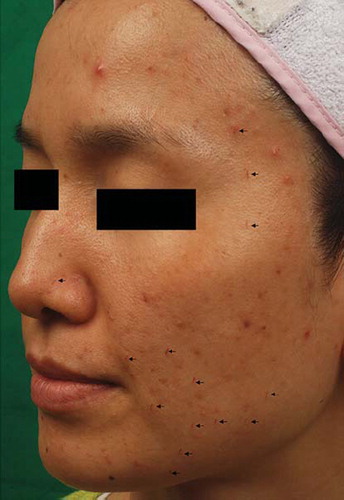Sirs,
A 33-year-old Korean woman with Fitzpatrick skin type IV presented with acne vulgaris and facial acne scars that had been progressing for over 5 years. She had previously been treated with systemic and topical antibiotics and a herbal medicine at various private clinics, none of which resulted in satisfactory improvement.
After giving informed consent, she was treated with a non-ablative 1450-nm diode laser (Smoothbeam™ laser; Candela, Wayland, MA, USA) for acne and its scars on her face using a 6-mm spot size and 14 J/cm2 with a 43-ms cryogen spray duration. Three weeks after the first session of the Smoothbeam laser treatment, the patient still presented with active acne vulgaris, and a second session of Smoothbeam laser treatment was delivered with the same energy settings as the first. Immediately after the treatment, she demonstrated no textural changes or blistering. The patient was not prescribed any medications (such as isotretinoin or antibiotics) between the treatments. However, 3 days after the second treatment, she presented numerous arcuate brownish crusted lesions on her cheeks (). The patient was instructed to use a non-comedogenic moisturizer (Physiogel™ cream; Stiefel Laboratories, Sligo, Ireland) several times daily to promote wound healing and prevent dryness until the post-therapy crusting subsided. A month after the conservative management of the crusting, the lesions were markedly improved with minimal post-therapy erythema. To find the cause of this unexpected reaction, we administered test shots against black paper with the laser tips tilted and observed an arcuate burn reaction ().
Figure 1. Numerous arcuate brownish crusted lesions (arrows) on the cheek following 1450-nm diode laser treatment equipped with a dynamic cooling device.

The dynamic cooling device (DCD) equipped in a non-ablative 1450-nm diode laser usually provides safe and effective epidermal cooling during laser treatment with minimal cold injury risk. However, according to previous reports, the risk of cryogen-induced arcuate-shaped hyperpigmentations should be considered (Citation1,Citation2), and, despite its extensive use, the cutaneous effects of DCD have not been fully characterized. Previously, Maruguchi and Maruguchi (Citation3) reported that of 17 patients treated with a non-ablative 1450-nm diode laser for inflammatory acne, one demonstrated crust formation. They suggested that the crusted lesions were related to the misalignment of the DCD with respect to the laser beam, resulting in excessive cryo-injury at the beam edge (Citation3). Cryogen-induced epidermal injuries may have been the cause of the crusted lesions in our patient as well, although there was no evidence of textural changes or blistering immediately after the laser delivery.
From the results of the test shots against the black paper, we suggest that unpredictable, uneven irradiation, caused by such things as not setting the laser tips perpendicular to the treatment plane or mechanical problems with the laser, may make specific portions of the beam highly potent. The crusts may also have been caused by deeply penetrating wavelengths together with the lack of epidermal surface cooling related to DCD misalignment (rather than the cryogen itself). Since a 1450-nm wavelength is absorbed in water, a water-containing epidermis is also apt to be damaged by a high-fluence laser beam.
In conclusion, although non-ablative 1450-nm diode lasers equipped with DCD can be safely and easily used for acne treatment, test shots against black paper before laser delivery to patients are recommended. Moreover, keeping the laser tip perpendicular to the treatment plane during the laser irradiation is necessary to prevent unexpected complications.
Acknowledgements
The authors have declared no conflict of interest.
References
- Datrice N, Ramirez-San-Juan J, Zhang R, Meshkinpour A, Aguilar G, Nelson JS, . Cutaneous effects of cryogen spray cooling on in vivo human skin. Dermatol Surg. 2006;32: 1007–12.
- Lee SJ, Park SG, Kang JM, Kim YK, Kim DH. Cryogen-induced arcuate shaped hyperpigmentation by dynamic cooling device. J Eur Acad Dermatol Venereol. 2008;22:883–4.
- Maruguchi Y, Maruguchi T. Treatment of inflammatory facial acne vulgaris: Comparison of the 1450-nm diode laser and conventional physical treatment. J Cosmet Laser Ther. 2006;8:167–9.

